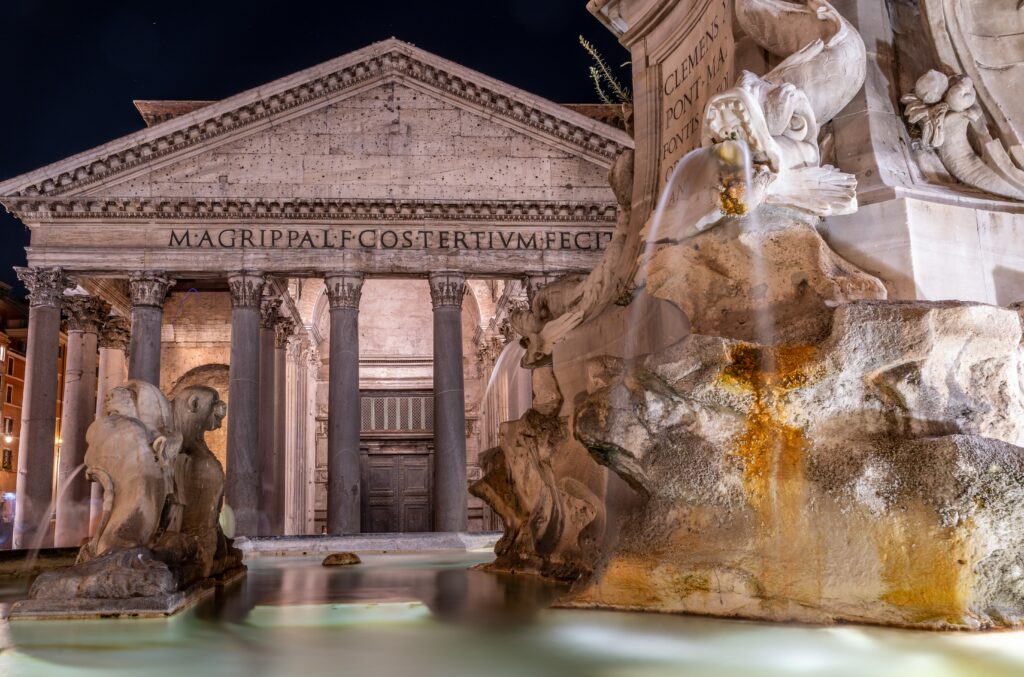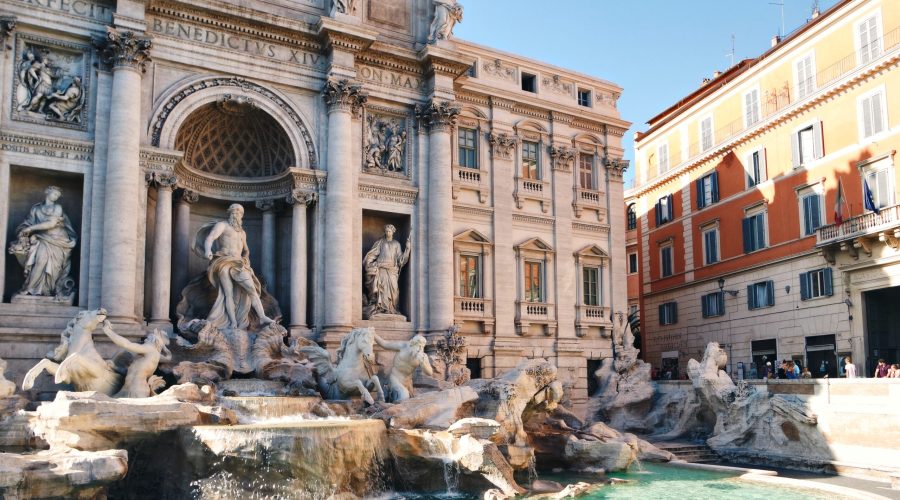Rome, often referred to as the “Eternal City,” is a captivating blend of ancient history, stunning architecture, and vibrant culture. From iconic landmarks to hidden gems, Rome offers a wealth of experiences that cater to every traveler’s interests. When visiting Rome you will find a lot of treasures, so If you’re planning a visit to this timeless destination, this guide is all you need!
Unforgettable Visits to Ancient Rome
1. The Colosseum: A Glimpse into Ancient Gladiatorial Combat
No visit to Rome is complete without setting foot in the awe-inspiring Colosseum. This iconic amphitheater, constructed over 2,000 years ago, was the epicenter of gladiatorial combat and grand spectacles. As you stand within its towering walls, imagine the roar of the crowds and the bravery of the fighters who once graced its arena. Guided tours offer insights into its history and architecture, allowing you to delve deeper into the heart of ancient Rome.
Want to skip the Colosseum line? Go early in the morning. The Colosseum opens to visitors at 8:30 a.m. If you arrive early you will spend much less time waiting and you will also avoid the intense heat of the Roman summer.
2. Roman Forum: Where History Comes to Life
Adjacent to the Colosseum lies the Roman Forum, a sprawling archaeological site that was the center of political, commercial, and social life in ancient Rome. Wander among the ruins of temples, basilicas, and arches that once defined the city’s landscape. Stand on the very ground where Cicero delivered speeches and Julius Caesar walked. The Roman Forum is a living testament to the layers of history that have shaped Rome.
3. Pantheon: A Marvel of Roman Engineering
The Pantheon, a marvel of Roman engineering and architecture, continues to amaze visitors to this day. Its perfectly preserved dome, with an oculus at its center, allows sunlight to filter into the magnificent interior. Originally a temple dedicated to the gods, the Pantheon stands as a symbol of Rome’s enduring legacy. Step inside and be captivated by the harmony of its design and the sense of wonder it evokes.

Art and Culture: Rome’s Renaissance and Beyond
1. Vatican Museums: A Treasure Trove of Art and History
The Vatican Museums house one of the most impressive collections of art and historical artifacts in the world. From Michelangelo’s breathtaking Sistine Chapel ceiling to Raphael’s Stanze di Raffaello, the museums offer a journey through centuries of artistic brilliance. Marvel at sculptures, paintings, and tapestries that have shaped the course of art history. A visit to the Vatican Museums is an immersion into the artistic heritage of humanity.
St Peter’s Basilica and the Vatican Museums tend to be even more crowded on Saturdays when Rome fills up with weekend visitors. We advise you to avoid going on Saturdays.
The Vatican Museum is closed on Sundays, except for the last Sunday of every month, when they are free.
2. Trevi Fountain: A Mythical Marvel
The Trevi Fountain, immortalized in films and literature, is a true masterpiece of baroque art. Toss a coin over your left shoulder into its crystal-clear waters, and according to legend, you’ll ensure your return to Rome. The fountain’s intricate sculptures and cascading water create a magical ambiance that draws visitors from all corners of the world. Whether by day or illuminated at night, the Trevi Fountain is a sight to behold.
3. Galleria Borghese: Intimate Encounters with Masterpieces
For an intimate art experience, venture to the Galleria Borghese. Housed within a lavish villa, this gallery boasts a curated collection of sculptures and paintings by masters such as Bernini, Caravaggio, and Raphael. The setting itself is a work of art, with grand rooms adorned with opulent decorations. Due to its limited capacity, reservations are recommended, ensuring a serene and personal exploration of its treasures.
Savoring Roman Delights: Cuisine and Atmosphere
When visiting Rome’s treasures, culinary is a must-try in the Eternal City!
1. Campo de’ Fiori Market: A Culinary Adventure
Experience the heart of Roman culinary culture at Campo de’ Fiori Market. The market is located in the square bearing the same name, near Piazza Navona (where it was originally located), and it is open from Monday to Saturday, from 07:00 to 14:00. On Sundays, the diverse community that manages the stands rightfully rests.
This bustling square transforms into a vibrant market each morning, offering an array of fresh produce, cheeses, meats, and artisanal goods. Immerse yourself in the lively atmosphere as you interact with local vendors and sample authentic Italian flavors. It’s an opportunity to taste the essence of Roman gastronomy.
2. Trastevere: Quaint Streets and Authentic Eateries
The neighborhood of Trastevere offers a taste of authentic Roman life. Its narrow, winding streets are lined with traditional trattorias, charming cafes, and artisan shops. It’s the perfect place to savor classic Roman dishes while soaking in the ambiance of this picturesque district. Whether it’s cacio e pepe, supplì, or a classic pizza, Trastevere’s eateries capture the flavors of Rome.

3. Piazza Navona: A Culinary Haven
Piazza Navona is not only a stunning square with Bernini’s Fountain of the Four Rivers; it’s also a haven for culinary delights. Surrounding the square, you’ll find a plethora of restaurants offering a diverse range of Italian and international cuisine. Indulge in a leisurely meal as you watch the world go by and absorb the atmosphere that makes Rome truly enchanting.
Visiting Rome’s Treasures in conclusion
In summary, Rome’s allure lies in its ability to seamlessly weave history, art, and culture into a captivating tapestry. From ancient ruins to Renaissance masterpieces, every corner of Rome holds a treasure waiting to be discovered. The Eternal City’s legacy continues to inspire and enchant travelers from across the globe.
As you reflect on your journey through visiting Rome’s treasures, remember that every street, monument, and piazza holds a story waiting to be shared.
FAQ
The ideal time to explore Rome is during the spring (April to June) and fall (September to October) seasons. The weather is pleasant, and the crowds are relatively smaller, allowing for a more immersive experience.
Yes, guided tours are highly recommended for both the Colosseum and Vatican City. Knowledgeable guides provide historical context, ensuring you gain a deeper understanding of the sites. Additionally, they often offer skip-the-line privileges, saving you time.
When visiting religious sites, it’s advisable to dress modestly. For men, long pants and covered shoulders are appropriate. Women should opt for knee-length skirts or pants and ensure their shoulders are covered. Wearing comfortable yet respectful attire is key.
Yes, it’s highly recommended to purchase tickets for popular attractions online in advance. This not only saves you time but also guarantees entry, especially during peak tourist seasons. Several official websites offer online ticket options.
Photography is permitted in most areas of the Colosseum and Vatican Museums, except in specific exhibits or sections where flash photography may damage artifacts. It’s advisable to check with the staff or signage at each site to ensure compliance with photography guidelines.
Apart from the renowned sites, consider visiting the Baths of Caracalla, the Capuchin Crypt, and the Appian Way. These lesser-known attractions offer unique insights into Rome’s history and are often less crowded, providing a more intimate experience.
Related Topics
- Spend 3 Memorable Days in Madrid: In this comprehensive guide, we’ll take you through a well-crafted itinerary to spend 3 memorable days in Madrid.
- The Incredible Benefits of Traveling: delve into the incredible benefits of traveling, shedding light on how it can open doors to self-discovery, learning, and a broader understanding of the world.




